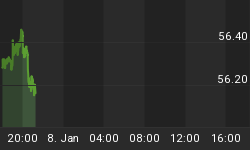The good news is:
Both the NYSE and NASDAQ AD lines, the NASDQ new high indicator and the Russell 2000 (R2K) were at new cycle highs as of Fridays close. This implies new highs for the major indices in the next 2-6 weeks.
The bad news is in the money supply.
In October of 1998 the market made a low with over 900 new lows on the NYSE. 900 new lows is a crash level and in the few times that number has been approached there has always been a re-test of the low. At the time my outlook was grim.
Don Hays, writing at the time for Wheatfirst securities, said the market was near its bottom and would be heading sharply upward because money supply had been growing at an annualized 24% rate.
Hays was right and I was wrong and I have been watching money supply ever since.
The chart below is a lousy reproduction of the money supply chart that Gordon Harms includes in his weekly report. The chart is divided by a dark line about 2/3 down from the top. The top 2/3 shows the Wilshire 5000 (WIL-5) on top and the 3 month rate of change (ROC) of the index on the bottom. The bottom 1/3 shows M3 (the broadest measure of money supply) in green and its 3 month ROC in red. The chart covers the period from the beginning of 2000 to last week (there is a modest lag in the data).
What I see in the chart is up moves in the WIL-5 lagging up moves in M3 by about 1 month and down moves in the WIL-5 lagging down moves in the growth of M3 by 2-3 months. The latest decline in the growth of M3 is the sharpest decline of the last 4 years shown on the chart and it began about 3 months ago.

A readable version of this chart is updated and sent as an attachment to all subscribers with Gordon Harms report. I forward the report late Monday or early Tuesday.
The indicator construction in the following two charts is a little arcane, but they have done a pretty good job of identifying turning points in the current cycle. The indicator is a momentum indicator of new highs divided by new highs + new lows. New highs and new lows are calculated on a trailing 6 week basis rather than 52 weeks as reported by the exchanges. The first chart shows the R2K and the indicator calculated from the component issues of the R2K. The second chart shows the S&P 500 (SPX) and the indicator calculated from the component issues of the SPX.
In the first chart I have drawn lines across the tops and bottoms of the price line to show that the R2K is near the top of its price channel. The HL indicator appears to be rolling over. The R2K has been the best performing of the major indices in the past 2 weeks adding 7.21%. The index near the top of its channel and the HL indicator rolling over suggests a limited near term upside for this index.

The chart below is similar to the one above except the index is the SPX and the indicator is calculated from the component issues of the SPX. I have drawn a line across the indicator tops for the last 3 months to show their progressive deterioration. This happened before prior to the early August low, but then the index was also trending downward.

Most of the indicators on most sectors are still heading sharply upward so their may be a little upside left in the next few days. The recent strength was seasonal and the seasonal period is over. Many of the indicators are near or even above the high side of their ranges so a downward turn is near.
I think we are close enough to the end of the recent up move that the major indices will be lower at the close Friday November 14 than they were at the close Friday November 7.
Thank You,
















